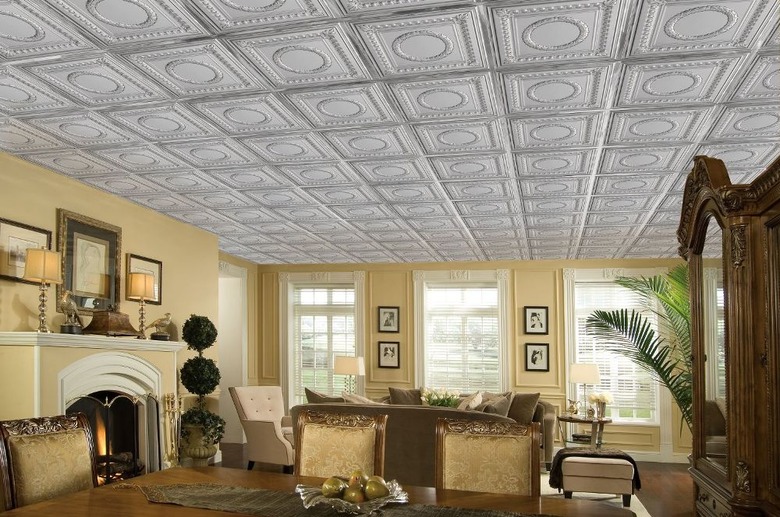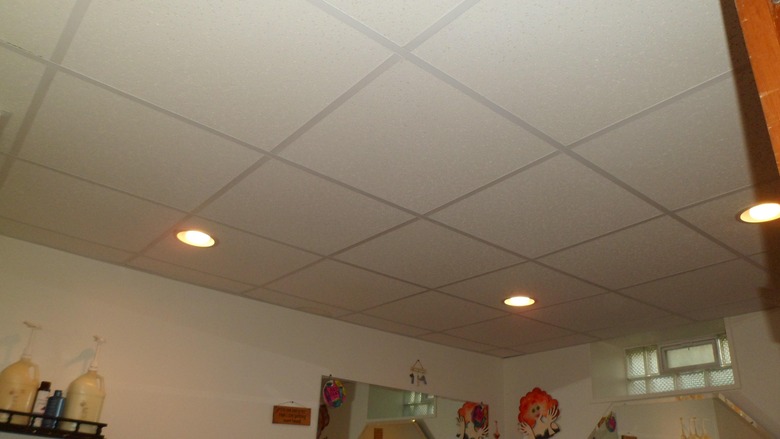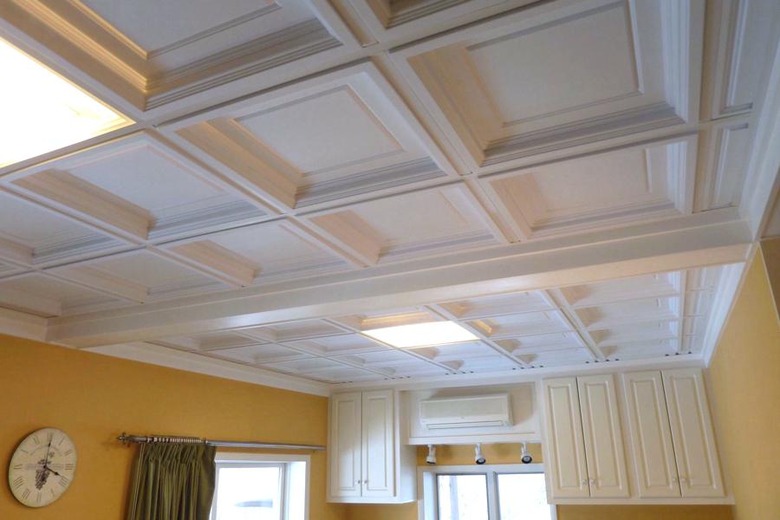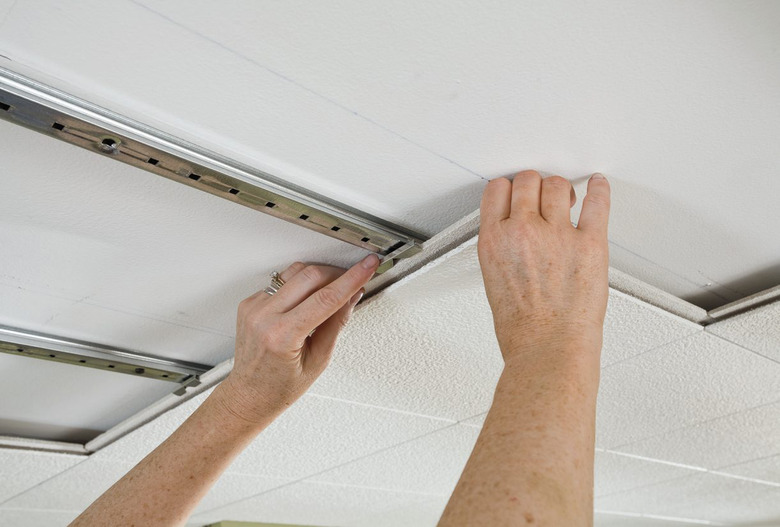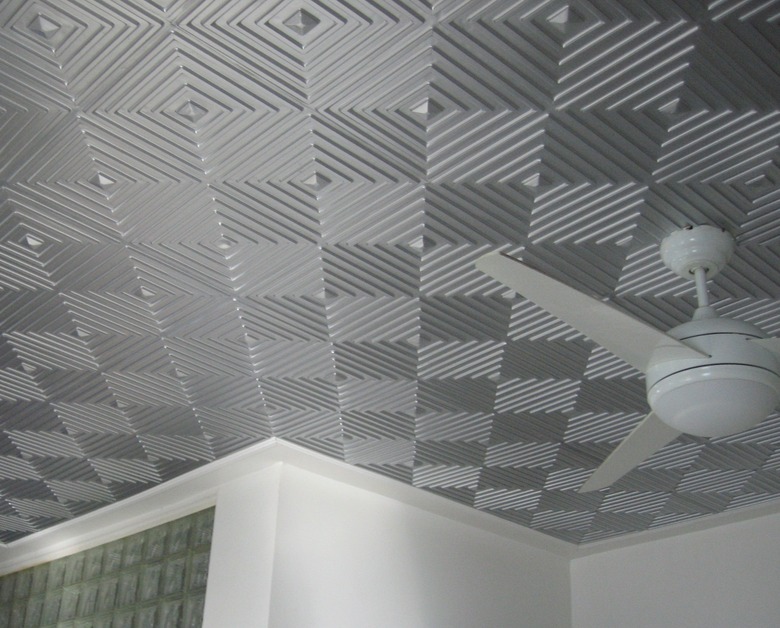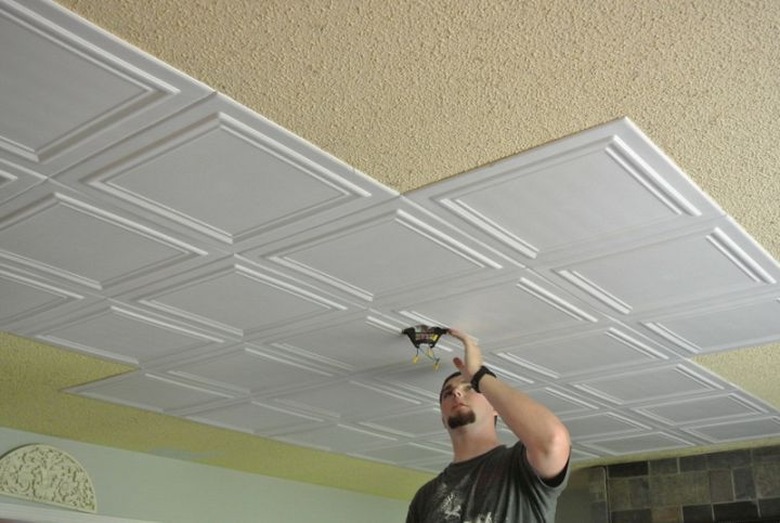A Homeowner's Guide To Ceiling Tile
Surely everyone is familiar with acoustic drop ceilings, ubiquitous in schools, offices and basement rec rooms for over 60 years. Suspended on a level grid below the actual ceiling or ceiling joists, the dropped ceiling and its noise-damping tiles present many advantages over a conventional plaster or plasterboard ceiling.
Convenient Camouflage
Convenient Camouflage
In commercial and business settings and in residential basements, the plumbing, electrical conduit, ductwork and other mechanicals are frequently exposed and extend below the level of the overhead joists. A dropped ceiling, positioned below the lowest pipe or duct, affords a smooth unbroken overhead surface and camouflage to the clutter, yet allows easy access to those utilities should they need repair or modification. Dropped ceilings are relatively easy to change. This can be advantageous especially in a commercial space that has periodic turnover. Without affecting the structural integrity of the space, the ceiling can be adapted by revising the grid or simply by substituting different ceiling tiles.
A Wealth of Options Overhead
A Wealth of Options Overhead
Traditional acoustic ceiling tiles are pressed from mineral fiber or sometimes fiberglass fibers into tiles 24 x 24 inches or panels 24 x 48 inches in size. Typically white, they are often given a subtle texture or perforated with a pattern of holes that enhance the acoustical properties of the tile and disguise slight imperfections. But traditional tiles fail to inspire. They're easily damaged and susceptible to water stains. So much more is possible.
Since those early utilitarian acoustic tiles, the design options presented by ceiling grid systems and their associated drop-in ceiling tiles have advanced considerably. Ceiling tiles are now offered in a variety of materials, colors, contours and patterns, and they can be mounted in myriad ways, some in a conventional dropped grid, some in a minimum clearance ceiling-mounted track system, some with no support grid at all and affixed directly to the old ceiling.
Even the pressed fiber tiles have taken on sleeker, more stylish appearances and are available in black (with black grid) as well as white. In addition, richly textured ceiling tiles molded from lightweight PVC have become popular. The PVC tiles can carry precise detail and are often molded to emulate wood, coffered plaster or pressed metal ceiling tiles and may be found in metallic, wood grain, and multi-colored finishes. PVC ceiling tiles are sized 24 inches by 24 inches, so they drop readily into a standard ceiling grid.
Beyond the Suspended Ceiling
Beyond the Suspended Ceiling
Although a suspended ceiling offers the benefit of smoothing out an irregular overhead ceiling full of pipes and ductwork, lowering the ceiling height is not always acceptable, such as in a basement with a ceiling that is already low. To overcome this, ceiling-mounted track systems require only an inch or two, thus maintaining your ceiling height while allowing you to choose from any of the wide range of drop-in ceiling tiles available and still permitting access to the ceiling for upgrades or repairs.
References
Nail-Up Ceilings
If you are willing to forego ready access to your ceiling surface, there are ceiling tile options that mount more-or-less directly to the ceiling, allowing you to dramatically change the look of the room while hiding many ceiling problems. Metal ceiling tiles, commonly known as "tin" ceilings, are actually stamped from steel or aluminum and are nailed in place. Many of the new metal ceiling tile designs are reproductions of designs popular in the nineteenth century and lend an historic ambiance to a room. Salvaged original tin ceiling tiles are also sometimes available. Although they seem light enough individually, cumulatively, metal ceiling tiles are so heavy that their nails would pull free if they were nailed directly to the plaster or wallboard ceiling. For that reason, you must first cover the ceiling with plywood mounted to the overhead joists and then nail the metal ceiling tiles to the plywood sheathing.
Glue-Up Ceilings
Glue-up tiles offer a lighter ceiling treatment and one that requires less advance preparation. Commonly molded from PVC plastic, many are the same tiles that can be used in a standard drop-ceiling grid. Unlike metal ceiling tiles, which must be cut with tin snips, plastic ceiling tiles may be trimmed using standard household scissors. Provided your ceiling is relatively smooth and intact, preparation for glue-up ceiling tiles requires little more than cleaning the ceiling surface of dust and anything that might interfere with adhesion.
The tiles are affixed using a quick-grab water-based adhesive applied to the back of the tiles using a roller. The quick-grab property of the adhesive is adequate to keep the tile firmly in place while allowing some lateral adjustment as you slide it into position. Installing a glue-up tile ceiling can be undertaken as a solo job, provided you are prepared to travel up and down the ladder frequently, alternately gluing and then placing the tiles. An easier method is to use two people—one to apply the glue and pass the tiles up, and another on the ladder to apply the tiles.
Expanded Foam Ceilings
Even lighter than the PVC tiles are ceiling tiles molded from polystyrene foam. Foam tiles are sized 24 x 24 inches and can be trimmed easily using a utility knife. Because polystyrene tiles are usually glued up with dabs of adhesive applied every few inches across the back, rather than with the roll-on adhesive used on PVC tiles, foam tiles are more forgiving of irregularities in the underlying ceiling surface. Like any ceiling tiles, polystyrene foam tiles can be painted, and that's an especially good idea since unpainted foam is difficult to keep clean. Should that be your plan, it's recommended that you paint the tiles before you install them.
So many options. Within each broad category of ceiling tile, there are manufacturers offering endless design solutions. Not all of the ceiling tile treatments are traditional or antique—some are boldly contemporary and sculptural. It's been said that ceilings are the last frontier in interior design. Here's your chance to explore that frontier.
